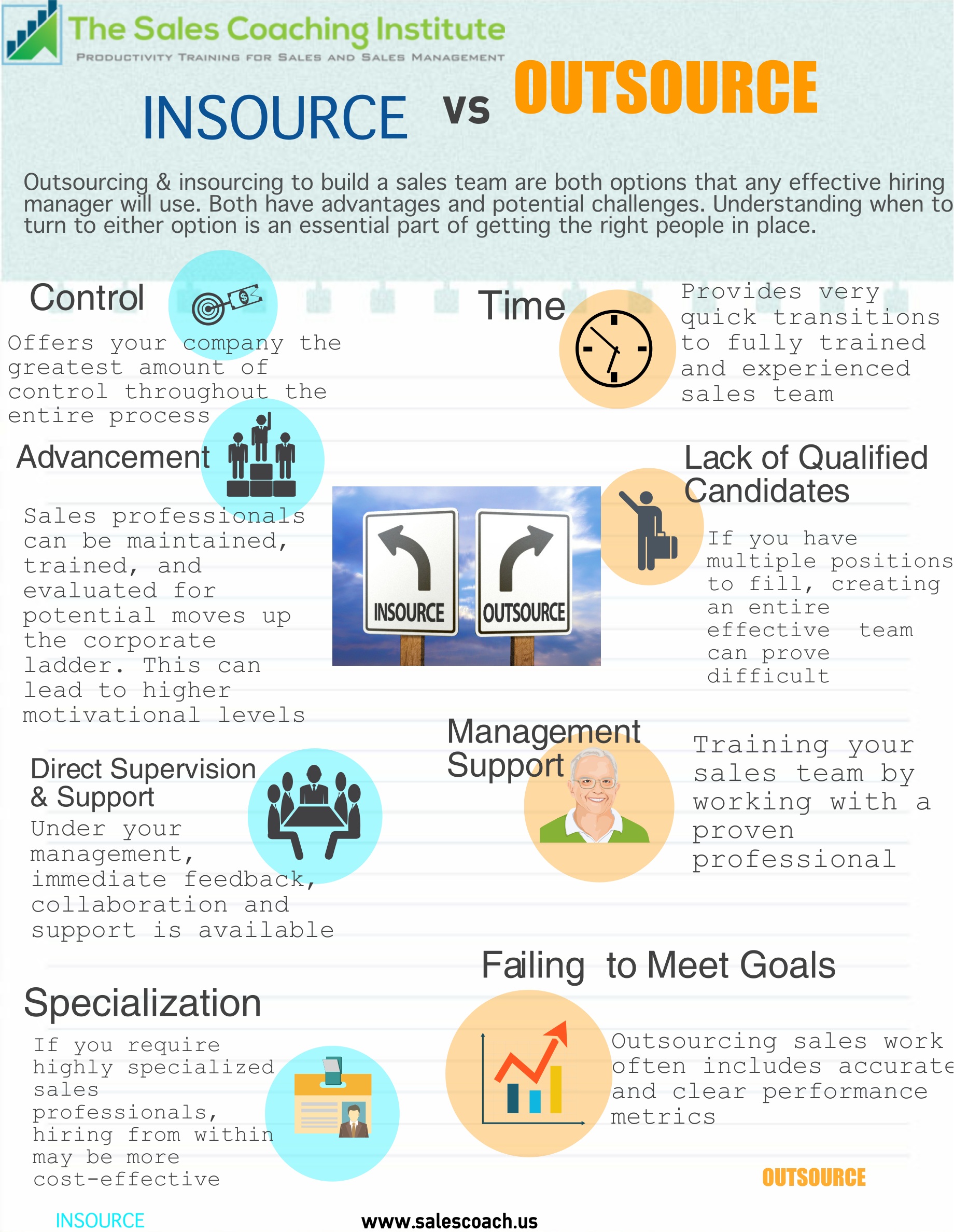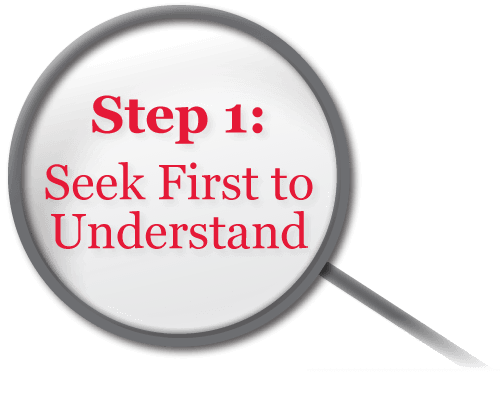There are many elements that are essential to not only having a good sales team but to developing and sustaining a top sales team. A strategic approach and knowing where and why you should insource or outsource specific sales positions and management opportunities is all part of the equation. Knowing the benefits of outsourcing sales versus insourcing sales can be crucial to your organization’s growth and success.

The Benefits of Insourcing Sales
Insourcing, or hiring from within the organization or through your own hirin g team for new recruits and candidates, offers the company the greatest in possible control over the entire process.
g team for new recruits and candidates, offers the company the greatest in possible control over the entire process.
A report from the Whitehouse from January 2012 titled “Investing in America: Building an Economy That Lasts”, takes a big picture and very detailed look at the increased hiring in the private sector, resulting the addition of 2 million jobs across the country in 2011 with the trend predicted to continue.
This trend has continued, with the Bureau of Labor Statistics reporting that 2.45 million jobs were added in the United States in 2015. However, this really hasn’t created a dent in the talent available with many qualified, experienced and highly effective sales professional out of work or underemployed.
When sales positions are posted and a company receives applications from talented and qualified candidates, insourcing makes good business sense. Through this process employees already fully trained in the business model and with solid product knowledge and experience can move into sales positions and also be maintained, trained and evaluated for potential moves up the corporate ladder.
This is one of the most critical factors to consider. When a business has a pool or stockpile of current sales professionals able to move into more advanced positions in team management, to take on lead in-house sales roles and to develop a solid network of qualified leads, the business and the employee both win.
The employee on the sales team sees and understands the potential for advancement which motivates them to continue with their professional development and leadership skill development. The company, in turn, has a long period of time to evaluate all employee skill levels, leadership potential and ability to work within the business model and achieve the individual and team goals.
In other words, with insourcing, there is a very low risk in promoting people up through the ranks of the sales team and even into management positions. The company also has full control over the training of the individuals, which can include cross-training for different positions within the sales team to provide a team that can function even through unforeseen issues should a critical team position be left vacant.
It may even be easier to think of the benefits of insourcing as having a farm team. Talent can be mentored, trained and evaluated across real-world experiences and situations before a promotion or a move is offered. Sales recruiting is key to attracting top talent that can be mentored and trained as specialists in your industry.
Additional Benefits of Insourcing Sales
There are other benefits to consider with insourcing of in-house sales positions that include:
 • Direct supervision and support – when the sales team is present and under your management, there is immediate feedback available, support when atypical issues arise, and full supervision of the team by a manager from the company.
• Direct supervision and support – when the sales team is present and under your management, there is immediate feedback available, support when atypical issues arise, and full supervision of the team by a manager from the company.
• Collaboration potential – problem solving and innovative ideas are more easily generated with the use of in-house teams. The ability to identify challenges or potential issues and develop workarounds that conform to the company policies or that are used to create new policies gives you full control over how these situations are addressed. Since management can be easily brought into the discussion, sales staff are more likely to understand they have a voice at the table and a vested interest in working to resolve the issue.
 • Specializations – often outsourcing companies have the same challenges as any business in finding highly specialized types of sales employees and managers. When a company has these specialized positions, hiring from within may actually be faster than trying to find an outsourcing company offering those specific skill sets in a cost-effective way. The argument for insourcing is solid, and it is one that is used across all departments in a company, not just in sales. Developing top company trained and experienced staff for sales or sales management and leader.
• Specializations – often outsourcing companies have the same challenges as any business in finding highly specialized types of sales employees and managers. When a company has these specialized positions, hiring from within may actually be faster than trying to find an outsourcing company offering those specific skill sets in a cost-effective way. The argument for insourcing is solid, and it is one that is used across all departments in a company, not just in sales. Developing top company trained and experienced staff for sales or sales management and leader.
The Benefits of Outsourcing Sales
Outsourcing sales is a way to bring in new blood, new ideas, new energy and even new possibilities to any company sales team. However, it is not always the right option for every company and business, and it needs to be carefully considered as there can be many benefits of outsourcing sales. However, making the decision to outsource sales staffing is not a simple task. There may be multiple options that make it difficult to insource these jobs, and it may be very challenging to vet potential candidates and get them in place, through the onboarding process and ready to start selling in the necessary window of time. Below, we outline the benefits of outsourcing sales.
In general outsourcing of sales teams makes good business sense when:
 • Time is of the essence – for startups and new businesses, or established businesses changing their business model or going through new product launches, outsourcing provides a very quick transition to a fully trained, experienced and cohesive sales team.
• Time is of the essence – for startups and new businesses, or established businesses changing their business model or going through new product launches, outsourcing provides a very quick transition to a fully trained, experienced and cohesive sales team.
• Lack of qualified candidates – sometimes, despite those 250 resumes per job opening, you are unable to find the correct candidates for the job. When you have multiple positions to fill or are adding a sales team or restructuring a sales department this lack of qualified candidates can  create significant challenges that may have a very large financial impact on the company.
create significant challenges that may have a very large financial impact on the company.
• Loss of qualified talent – in a survey by Glassdoor for Employers it was found that 46% of those defined as Millenials left their job because of a perceived lack of opportunity for career growth. To add to this 65% of this same group were highly skeptical of the promises made by employers, and were more likely to change jobs for an opportunity for advancement, even if a lower base salary was offered. When companies are constantly losing qualified talent, it is very challenging to develop an effective inside sales team. With an outsourced sales team, this is a non-issue as the sales staff has their own internal progression or advancement model. These 4 professionals are also not as susceptible to heavy recruitment from the competition, creating a more stable sales workforce for short or long-term deployment with the company.
 • Failing to meet goals – this is a complicated process that can include poor performance on the part of the sales team as well as incorrect metrics developed or the inside sales team. In a report by memoryBlue, many companies over or underestimate the metrics they use as they related to industry averages. This can include the number of calls made per sales rep, the amount of sales or other factors. With an outsourced sales team, the sales model will already include these metrics, providing more accurate information and a clear picture of performance.
• Failing to meet goals – this is a complicated process that can include poor performance on the part of the sales team as well as incorrect metrics developed or the inside sales team. In a report by memoryBlue, many companies over or underestimate the metrics they use as they related to industry averages. This can include the number of calls made per sales rep, the amount of sales or other factors. With an outsourced sales team, the sales model will already include these metrics, providing more accurate information and a clear picture of performance.
 • Management support – with the services offering outsourced inside sales teams it is also possible to bring in management with the team. This can be a terrific option for a smaller company or a startup, allowing the in-house management team to train and develop until they are ready to assume the leadership roles. When transforming a sales team changing management strategy and skill set may also be an important consideration and this option allows for that time, training and experience working with a proven professional. A great example of Management Support is working with a Virtual Vice President of Sales.
• Management support – with the services offering outsourced inside sales teams it is also possible to bring in management with the team. This can be a terrific option for a smaller company or a startup, allowing the in-house management team to train and develop until they are ready to assume the leadership roles. When transforming a sales team changing management strategy and skill set may also be an important consideration and this option allows for that time, training and experience working with a proven professional. A great example of Management Support is working with a Virtual Vice President of Sales.
Additional benefits of outsourcing sales can include top companies providing support to the in-house management team to work with B2B sales companies to hire, onboard and develop protocols for creating the insourced sales and management team that will eventually take over. This places the outsourcing company in the role of both a consultant as well as a mentor, literally training and developing the replacement in-house team in the same effective model they are using. Metrics and analysis methods in tracking team effectiveness and success can be further refined to accurately reflect the needs of the company.
Outsourcing sales is typically considered a temporary option for most companies, but the duration of the service can be months to years. While it is difficult to find specific statistics on outsourcing inside sales, in the United States alone in 2013 Source Line Computer Economics reports that 2.6 million jobs were outsourced, with about 20% of companies reporting that the outsourcing was done to transform and/or reorganize internally. In addition, about 9% of companies in the same survey reported the outsourcing was done to speed up the time to enter the market. While this survey was completed on outsourcing to different countries, many of these jobs were in sales and customer service.
You can also consider outsourcing digital marketing by working with a reputable SEO firm to bring in additional sales leads.








 g team for new recruits and candidates, offers the company the greatest in possible control over the entire process.
g team for new recruits and candidates, offers the company the greatest in possible control over the entire process.
 • Specializations – often outsourcing companies have the same challenges as any business in finding highly specialized types of sales employees and managers. When a company has these specialized positions, hiring from within may actually be faster than trying to find an outsourcing company offering those specific skill sets in a cost-effective way. The argument for insourcing is solid, and it is one that is used across all departments in a company, not just in sales. Developing top company trained and experienced staff for sales or sales management and leader.
• Specializations – often outsourcing companies have the same challenges as any business in finding highly specialized types of sales employees and managers. When a company has these specialized positions, hiring from within may actually be faster than trying to find an outsourcing company offering those specific skill sets in a cost-effective way. The argument for insourcing is solid, and it is one that is used across all departments in a company, not just in sales. Developing top company trained and experienced staff for sales or sales management and leader. • Time is of the essence – for startups and new businesses, or established businesses changing their business model or going through new product launches, outsourcing provides a very quick transition to a fully trained, experienced and cohesive sales team.
• Time is of the essence – for startups and new businesses, or established businesses changing their business model or going through new product launches, outsourcing provides a very quick transition to a fully trained, experienced and cohesive sales team. create significant challenges that may have a very large financial impact on the company.
create significant challenges that may have a very large financial impact on the company. • Failing to meet goals – this is a complicated process that can include poor performance on the part of the sales team as well as incorrect metrics developed or the inside sales team. In a report by memoryBlue, many companies over or underestimate the metrics they use as they related to industry averages. This can include the number of calls made per sales rep, the amount of sales or other factors. With an outsourced sales team, the sales model will already include these metrics, providing more accurate information and a clear picture of performance.
• Failing to meet goals – this is a complicated process that can include poor performance on the part of the sales team as well as incorrect metrics developed or the inside sales team. In a report by memoryBlue, many companies over or underestimate the metrics they use as they related to industry averages. This can include the number of calls made per sales rep, the amount of sales or other factors. With an outsourced sales team, the sales model will already include these metrics, providing more accurate information and a clear picture of performance. • Management support – with the services offering outsourced inside sales teams it is also possible to bring in management with the team. This can be a terrific option for a smaller company or a startup, allowing the in-house management team to train and develop until they are ready to assume the leadership roles. When transforming a sales team changing management strategy and skill set may also be an important consideration and this option allows for that time, training and experience working with a proven professional. A great example of Management Support is working with a
• Management support – with the services offering outsourced inside sales teams it is also possible to bring in management with the team. This can be a terrific option for a smaller company or a startup, allowing the in-house management team to train and develop until they are ready to assume the leadership roles. When transforming a sales team changing management strategy and skill set may also be an important consideration and this option allows for that time, training and experience working with a proven professional. A great example of Management Support is working with a 
